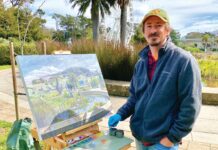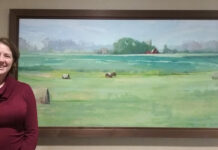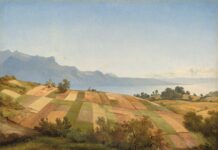
Kim Casebeer is definitely a pastelist who has much to share with both oil painters and other pastelists. Her scheduled demonstration at the Plein Air Convention & Expo (PACE) in Monterey, California, in April will show why.

“Summer Day, Laurel Branch,” by Kim Casebeer, pastel on museum board, 10 x 12 in.
Casebeer says her roots are definitely in the world of pastel, but she does switch media between pastels and oil paints. “I tend to not hop back and forth too much — I’ll be in a pastel mode for a while and then be in an oil mode for a while,” she says. “There are a number of similarities between the two. It doesn’t matter what medium in which you are working, you still have to concern yourself with values, proper composition, patterns, shapes, lines, and the like.”

“Colors of the Coast,” by Kim Casebeer, pastel on museum board, 6 x 8 in.
In either medium, Casebeer works from thin to thick in terms of pigment application. The two media inspire each other in Casebeer’s approach. In fact, the demonstration on the Pastel Stage at PACE will feature her painting a larger pastel from a small oil study. The subject matter is likely to be clouds, or a sky. She notes, “Having both of those media will help me demonstrate their similarities and differences, and how the two approaches help me when I go back and forth between them.”

“Dappled Gold,” by Kim Casebeer, oil, 9 x 12 in.
Casebeer says she could be classified as an impressionist, especially given her avoidance of tight realism, and the way hers and most pastels reward color mixing in the mind’s eye rather than on the palette or surface. “Like the impressionists, I put two different colors of the same value side by side and let them visually mix,” she says. More than anything, though, she loves texture.

“Lights of Tombstone,” by Kim Casebeer, pastel on museum board, 8 x 12 in.
Pastel is a wonderful medium for someone who likes texture, but Casebeer finds that the pastel papers on the market don’t give her all she’s looking for. She’ll use Wallis paper for quick studies, but for more finished or larger work, Casebeer will prepare her own surface. “I like to build up layers as you would in oil paints,” she says. “You can’t do that with just any pastel paper. I create a surface textured enough that it can take several layers of pastel. I try to build at least three layers when I paint.”

“Tree Sketch, 15 Minutes,” by Kim Casebeer, pastel on paper, 7 1/2 x 8 in.
To make her surface, she starts with 4-ply museum board, which she coats twice on both sides with store-bought gesso. She then mixes acrylic medium with finely ground pumice from the hardware store and just enough water to get the right consistency. “I brush it on with a 4″ house painting brush when it gets buttery,” says Casebeer. “I experimented with straight brushstrokes, but I didn’t like it. One of the things I was trying to get away from was the uniform look of a mechanically made surface. I give it two layers of that mixture, applied in different directions to give it a natural look. You can see my brush marks through the pastel on a finished piece. It’s a surface tailored toward keeping things really loose.”

“Tucson Mountain Sunset,” by Kim Casebeer, pastel on museum board, 8 x 16 in.
The Kansas artist doesn’t appear to have a strong preference between her two media, although pastels seem to have the upper hand. Casebeer will say that some subject matter seems better suited to pastel. “Painting early spring, with the new leaves and lots of delicate things happening, is really fun in pastel,” she says. “But I don’t know that there’s a big difference for most subject matter. Oftentimes I feel pastel is more direct. The seasons don’t make a big difference in terms of weather, although extreme heat or cold is more of an issue with oil paints.” She adds with a laugh, “But if it gets around zero degrees, I don’t really go out anyway.”

“Ocean Side Meadow,” by Kim Casebeer, oil, 8 x 10 in.
Casebeer will be teaching at the Plein Air Convention & Expo, which will be held April 13-17 in Monterey, California. Last year, more than 700 artists basked in the perfect weather and learned from 70 instructors. This year, organizers expect even more participants. Learn more here.




